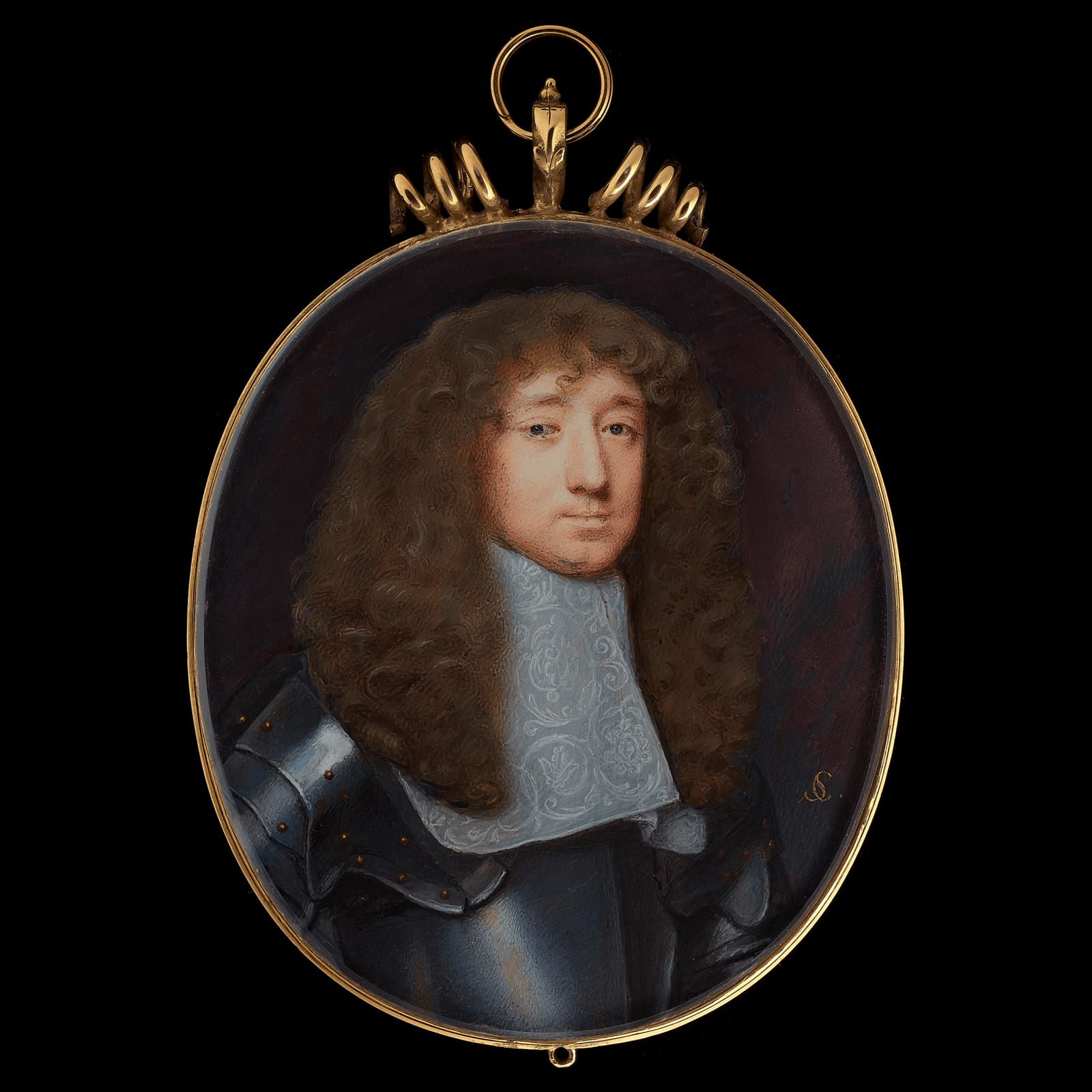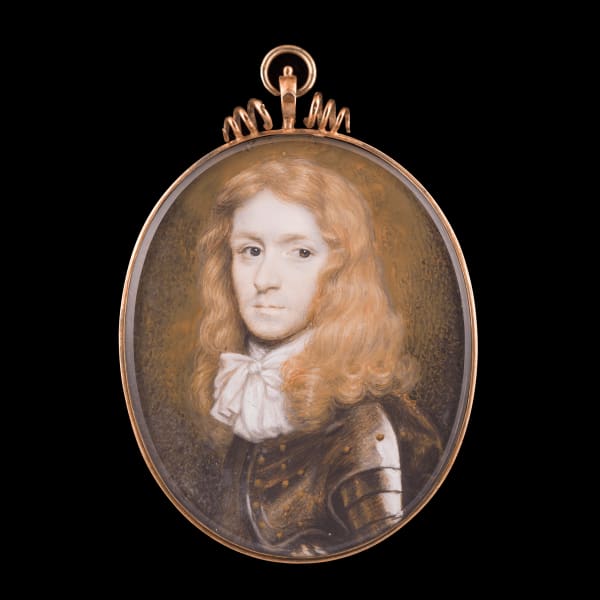
Samuel Cooper
Portrait of Henry Alexander, 4th Earl of Stirling (d.1691), c. 1666
Watercolour and bodycolour on vellum
Oval, 2 ⅜ in. (68 mm) high
Signed with monogram ‘SC’
Philip Mould & Co.
%3Cdiv%20class%3D%22artist%22%3ESamuel%20Cooper%3C/div%3E%3Cdiv%20class%3D%22title_and_year%22%3E%3Cspan%20class%3D%22title_and_year_title%22%3EPortrait%20of%20Henry%20Alexander%2C%204th%20Earl%20of%20Stirling%20%28d.1691%29%3C/span%3E%2C%20%3Cspan%20class%3D%22title_and_year_year%22%3Ec.%201666%3C/span%3E%3C/div%3E%3Cdiv%20class%3D%22medium%22%3EWatercolour%20and%20bodycolour%20on%20vellum%3C/div%3E%3Cdiv%20class%3D%22dimensions%22%3EOval%2C%202%20%E2%85%9C%20in.%20%2868%20mm%29%20high%3Cbr/%3E%0A%3Cbr/%3E%0A%3C/div%3E%3Cdiv%20class%3D%22signed_and_dated%22%3ESigned%20with%20monogram%20%E2%80%98SC%E2%80%99%3C/div%3E
To view all current artworks for sale visit philipmould.com
Henry Alexander, 4th Earl of Stirling was an important Scottish nobleman. The earldom had been established by his grandfather, William (1577-1640), who was awarded the title by Charles I (1600-1649) in the honours awarded to coincide with his coronation as King of Scotland. Like many ambitious Scots, the first earl had moved with James VI and I (1574-1619) to London, where he made his career as a noted poet and courtier, later serving as Secretary of State for Scotland. He was also an important figure in the early colonised history of North America, founding the Scottish colony in Canada today known as Nova Scotia. The coat of arms of the knights baronet of Nova Scotia that he persuaded James to found in 1624 remains the coat of arms of the province to this day.
The family would have been well known to Charles II (1630-1685) through the actions of the first earl who had dedicated his 1604 work Paraenesis to the young prince when it was republished in 1637 (the previous dedicatee, Prince Henry (1594-1612), having died since its first edition). Paraenesis was a guide to good rulership, in which Stirling expressed his belief that a wise prince should consult books, love virtue and seek good advice from trusted counsellors. Whilst these were not all lessons that Charles II heeded, he is unlikely to have forgotten this contact with the fourth earl’s grandfather at such a young and impressionable age.
The title passed to Henry Alexander via his father, the third son of the first Earl (the second earl, the infant grandson of the first earl through his eldest son, died only a few months after the first earl).
In part due to the vast sums accrued by the first earl in debts, his successors never again enjoyed the prominence at court that he had enjoyed in his own lifetime. Nevertheless, the family remained one of influence, as can be seen by the fact that the fourth earl is here painted by Samuel Cooper, the king’s personal limner.
As the nephew of court miniaturist John Hoskins the elder (c.1590-1665), Cooper was extremely well placed to become one of the most skilled and successful miniaturists of the age. In his youth, Cooper refined the methods that he had been taught by his nephew through intense study of the works of Sir Anthony Van Dyck (1599-1641). With his work being defined by an ambitious approach to composition and a sense of painterly flair, Cooper successfully brought the insights that he had gleaned form the work of Van Dyck to bear on his work in miniature. His appointment as limner to the king in 1663 confirmed Cooper’s status as the pre-eminent miniaturist then working in Britain. With Richard Graham (fl. 1695-1727) recording that he was known to ‘the greatest Men of France, Holland, and his own country, and by his Works more universally known in all the parts of Christendom’, Cooper held a place among the highest ranks of the British – and even European – cultural and intellectual elite. Charming and widely regarded, in the words of Charles Beale (c. 1660-1726?), as ‘the most famous limner in the world for a face’, Cooper became friends with many whom he painted. He died aged 64 at the height of his powers.
Henry Alexander, 4th Earl of Stirling was an important Scottish nobleman. The earldom had been established by his grandfather, William (1577-1640), who was awarded the title by Charles I (1600-1649) in the honours awarded to coincide with his coronation as King of Scotland. Like many ambitious Scots, the first earl had moved with James VI and I (1574-1619) to London, where he made his career as a noted poet and courtier, later serving as Secretary of State for Scotland. He was also an important figure in the early colonised history of North America, founding the Scottish colony in Canada today known as Nova Scotia. The coat of arms of the knights baronet of Nova Scotia that he persuaded James to found in 1624 remains the coat of arms of the province to this day.
The family would have been well known to Charles II (1630-1685) through the actions of the first earl who had dedicated his 1604 work Paraenesis to the young prince when it was republished in 1637 (the previous dedicatee, Prince Henry (1594-1612), having died since its first edition). Paraenesis was a guide to good rulership, in which Stirling expressed his belief that a wise prince should consult books, love virtue and seek good advice from trusted counsellors. Whilst these were not all lessons that Charles II heeded, he is unlikely to have forgotten this contact with the fourth earl’s grandfather at such a young and impressionable age.
The title passed to Henry Alexander via his father, the third son of the first Earl (the second earl, the infant grandson of the first earl through his eldest son, died only a few months after the first earl).
In part due to the vast sums accrued by the first earl in debts, his successors never again enjoyed the prominence at court that he had enjoyed in his own lifetime. Nevertheless, the family remained one of influence, as can be seen by the fact that the fourth earl is here painted by Samuel Cooper, the king’s personal limner.
As the nephew of court miniaturist John Hoskins the elder (c.1590-1665), Cooper was extremely well placed to become one of the most skilled and successful miniaturists of the age. In his youth, Cooper refined the methods that he had been taught by his nephew through intense study of the works of Sir Anthony Van Dyck (1599-1641). With his work being defined by an ambitious approach to composition and a sense of painterly flair, Cooper successfully brought the insights that he had gleaned form the work of Van Dyck to bear on his work in miniature. His appointment as limner to the king in 1663 confirmed Cooper’s status as the pre-eminent miniaturist then working in Britain. With Richard Graham (fl. 1695-1727) recording that he was known to ‘the greatest Men of France, Holland, and his own country, and by his Works more universally known in all the parts of Christendom’, Cooper held a place among the highest ranks of the British – and even European – cultural and intellectual elite. Charming and widely regarded, in the words of Charles Beale (c. 1660-1726?), as ‘the most famous limner in the world for a face’, Cooper became friends with many whom he painted. He died aged 64 at the height of his powers.
Henry Alexander, 4th Earl of Stirling was an important Scottish nobleman. The earldom had been established by his grandfather, William (1577-1640), who was awarded the title by Charles I (1600-1649) in the honours awarded to coincide with his coronation as King of Scotland. Like many ambitious Scots, the first earl had moved with James VI and I (1574-1619) to London, where he made his career as a noted poet and courtier, later serving as Secretary of State for Scotland. He was also an important figure in the early colonised history of North America, founding the Scottish colony in Canada today known as Nova Scotia.
Provenance
Possibly either John Alexander, 4th Earl of Stirling (c.1633-91) or his daughterJudith Alexander (d. 1724), who married Sir William Trumbull (1639-1716) to their son;
William Trumbull (1708-1760) to their daughter;
Mary Trumbull (1741-1769) who married Colonel the Hon. Martin Sandys (1729-1768) to their daughter;
Mary, Marchioness of Downshire, Baroness Sandys (1764-1836);
thence by descent
Literature
Bennet & Son, Valuation of Miniatures, Medals & Curios for Captain A Hill of Welford Bray Co. Dublin, 11 December 1896, p.1; 'The Earl of Stirling by S. Cooper / £42'
Share
- X
- Tumblr
1
of
11
Related artworks
-
![Peter Cross, James Scott [Crofts], Duke of Monmouth and first duke of Buccleuch (1649-85), 1681](data:image/gif;base64,R0lGODlhAQABAIAAAAAAAP///yH5BAEAAAAALAAAAAABAAEAAAIBRAA7) Peter CrossJames Scott [Crofts], Duke of Monmouth and first duke of Buccleuch (1649-85), 1681
Peter CrossJames Scott [Crofts], Duke of Monmouth and first duke of Buccleuch (1649-85), 1681 -
 Richard GibsonPortrait miniature of a Young Gentleman wearing plate armour comprised of cuirass and spaulders secured with gilt rivets, elaborately tied with linen cravat, c. 1650-90
Richard GibsonPortrait miniature of a Young Gentleman wearing plate armour comprised of cuirass and spaulders secured with gilt rivets, elaborately tied with linen cravat, c. 1650-90 -
 Richard GibsonA Gentleman, wearing gold edged ochre doublet slashed at the sleeve to reveal white chemise, white stock and lace jabot, natural wig, c. 1650-60
Richard GibsonA Gentleman, wearing gold edged ochre doublet slashed at the sleeve to reveal white chemise, white stock and lace jabot, natural wig, c. 1650-60 -
 Samuel CooperPortrait miniature of Baptist May (1628-97), wearing brass-studded armour and white lace jabot, with a full-bottomed wig, c. 1660
Samuel CooperPortrait miniature of Baptist May (1628-97), wearing brass-studded armour and white lace jabot, with a full-bottomed wig, c. 1660 -
 Richard GibsonSir Patience Ward(e) (1629-1696), wearing black cloak and white lawn collar, his hair worn long, c. 1653
Richard GibsonSir Patience Ward(e) (1629-1696), wearing black cloak and white lawn collar, his hair worn long, c. 1653 -
 Richard GibsonA Lady, wearing brown dress over white chemise and blue cloak held with jewels, her light brown hair curled, c. 1675
Richard GibsonA Lady, wearing brown dress over white chemise and blue cloak held with jewels, her light brown hair curled, c. 1675 -
 Samuel CooperA Young Gentleman, wearing gilt-edged armour and lawn collar, c. 1645
Samuel CooperA Young Gentleman, wearing gilt-edged armour and lawn collar, c. 1645
![Peter Cross, James Scott [Crofts], Duke of Monmouth and first duke of Buccleuch (1649-85), 1681](https://artlogic-res.cloudinary.com/w_600,c_limit,f_auto,fl_lossy,q_auto/artlogicstorage/philipmouldgallery/images/view/c9eb879a0271ac4654f9fd9586a96e68p/picturearchive-historicalportraits-peter-cross-james-scott-crofts-duke-of-monmouth-and-first-duke-of-buccleuch-1649-85-1681.png)





